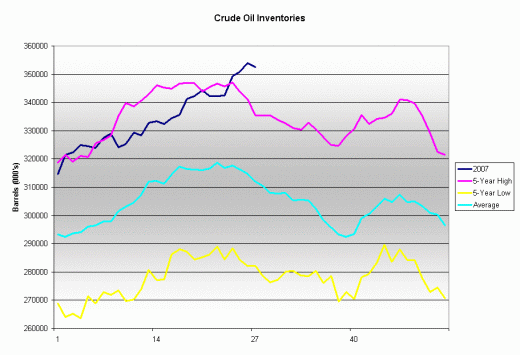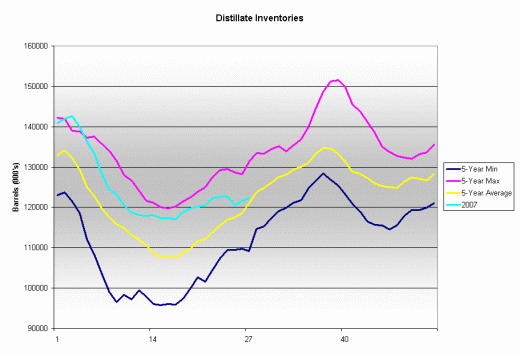The Trouble with Refining Crude OIl
Commodities / Crude Oil Jul 13, 2007 - 06:10 PM GMTBy: Elliot_H_Gue
 Earlier this week, I was invited on Canadian television to offer a real-time analysis of the latest weekly petroleum report from the US EIA. The Petroleum Status Report is released each week at 10:30 am EST, detailing exactly how much oil, gasoline and distillate is currently in storage in the US.
Earlier this week, I was invited on Canadian television to offer a real-time analysis of the latest weekly petroleum report from the US EIA. The Petroleum Status Report is released each week at 10:30 am EST, detailing exactly how much oil, gasoline and distillate is currently in storage in the US.
Sometimes, the report just isn't all that interesting nor does it always have much of an impact on market prices for crude and gasoline. But that certainly hasn't been the case this year.
The weekly status report continues to reveal a highly unusual and persistent problem developing in the US market for crude and refined products. Specifically, the US is absolutely awash in crude oil, yet it's experiencing a growing shortage of motor gasoline just as we enter the peak of the summer driving season.
And, more recently, the gasoline supply shortage is starting to have knock-on effects for supplies of another key class of refined products known as distillates. Key distillate fuels include diesel and heating oil. This will become a bigger issue as we head into the winter heating season; heating oil is still a key source of heat in certain regions of the nation, and the winter marks a season of heavy demand for distillate fuel.
Before we delve into the market for refined products, however, check out the chart of crude oil inventories:

Source: EIA
This chart includes four separate lines plotted over a 52-week time scale. The light blue line represents the five-year average of crude oil in storage, while the purple and yellow lines represent the five-year high and low of crude storage, respectively. Note the five-year highs and lows don't include data for 2007. The final dark blue line represents the progression of crude inventories so far in 2007.
On Wednesday, the government reported a drawdown in crude oil inventories of 1.4 million barrels, a significantly larger decline than was expected. However, this hasn't changed the broader picture for crude oil inventories this year. For most of 2007, crude oil inventories have remained at multi-year highs and far-above-average levels.
At first blush, this might seem totally incongruent with the recent action in crude. After all, oil prices have generally been climbing during the past few months and currently stand at well more than $70 per barrel. Typically, one would expect crude inventories that far above normal levels to put downward pressure on prices. And oftentimes a build-up in crude inventories signals weak oil demand.
But that's just not the case today. The problem this year has been a string of refinery outages and shutdowns. Refinery capacity utilization in the US stands at 90.2 percent for this past week. That means that the nation's refineries are operating at a touch more than 90 percent of their total rated capacity.
But the average refinery utilization for this time of the summer is far higher than that. Normally, at this time of year, refiners are working flat out to pump as much gasoline as possible for the summer driving season. On average, capacity utilization in July has run at or a little more than 95 percent.
In other words, the reason all that crude is welling up in storage is that the refineries just aren't operating well enough to refine the oil into gasoline. That's exactly why gasoline inventories look like this:

Source: EIA
This is the same basic chart I showed above for crude. However, note that gasoline inventories are currently at five-year lows for this time of year. Refiners were unable to build stocks at a normal pace in the spring because of all those refinery shutdowns. Therefore, gasoline stocks are at dangerously low levels at a time of peak demand.
The high crude oil stocks and low inventories of gasoline are both the symptom of a refining issue in the US. Global oil demand isn't slowing down one whit. In fact, the International Energy Agency (IEA) recently revised up its intermediate-term forecasts for global oil demand. The IEA also called into question Organization of the Petroleum Exporting Countries (OPEC's) ability to meet that demand in the coming years.
The final piece to this puzzle is the distillates inventories. Check out the third and final chart below:

Source: EIA
I alluded to the distillates in my interview on Wednesday as well as in the latest issue of The Energy Strategist . Basically, because gasoline inventories are so low, refiners are maximizing their output of motor gasoline right now. This is necessary to keep up with demand.
As the chart shows, in a normal year the peak demand for distillates (heating oil) is in winter. This is when stocks tend to draw down. Refiners tend to build distillate stocks from April through September, ahead of the heating season.
This year, distillate stocks began the year at high levels. This was mainly a hangover from the warm winter of 2005-06 that lowered overall demand for heating oil. And a warm start to the 2006-07 winter also hit heating oil demand.
But distillate inventories haven't yet begun their normal seasonal build. From the above-average levels that prevailed early in 2007, distillate inventories are now at the average. And I suspect we'll continue to see a slower-than-average build in distillate inventories in the next couple months. The reason is that refiners will be transfixed on keeping on top of motor gasoline demand.
This could be a problem for next winter. Heating oil prices are already on the rise. And if inventories continue falling, we could see a dramatic spike in pricing as the winter heating season starts to kick in late in the fall.
The refinery problems that have been plaguing the gasoline market this year are likely to spread to next winter's heating season as well. This bodes well for continued strong profitability for the refiners, who benefit from high prices for gasoline and heating oil relative to crude.
Eventually, as refiners gradually start to come back on line, this will also bode well for crude oil prices. Those excess supplies of crude could disappear quickly as refiners seek to rebuild stocks to more normal levels.
As I've written before, the US refining situation is behind the fact that US benchmark W&T Offshore crude is trading at a significant discount to European benchmarks such as Brent. Eventually, I expect W&T to close that discount and move toward its normal premium over Brent. I suspect this will happen at prices north of $80 per barrel.
And finally, a tight heating oil market bodes well for natural gas prices. Natural gas is another common commodity used to heat homes during the winter. Therefore, high heating oil prices tend to boost demand for gas.
By Elliott H. Gue
The Energy Letter
© 2007 Elliott H. Gue
Elliott H. Gue is editor of The Energy Letter , a bi-weekly e-letter as well as editor of The Energy Strategist , a premium bi-weekly newsletter on the energy markets. Mr. Gue is also associate editor for Personal Finance , where he contributes his knowledge of the energy markets.
Mr. Gue has a Master's of Finance degree from the University of London and a Bachelor of Science degree in Economics and Management from the University of London , graduating in the top 3 percent of his class. Mr. Gue was the first American student to ever complete a full degree at that university.
Elliott H. Gue Archive |
© 2005-2022 http://www.MarketOracle.co.uk - The Market Oracle is a FREE Daily Financial Markets Analysis & Forecasting online publication.


